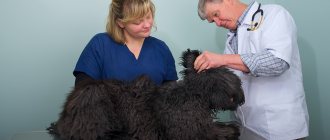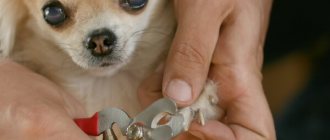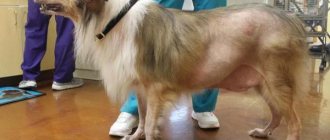One of the most sensitive organs in dogs is the ears. Due to the peculiarities of the anatomical structure, the hearing organs suffer from various diseases caused by fungal microorganisms or bacterial microflora more often than in other pets.
If a dog scratches its ears, the owner should immediately contact a veterinarian. First of all, it is necessary to establish the cause of the dog’s itching and discomfort, and then adequate treatment must be prescribed.
Otodectosis
Otodectosis is an ear mite, popularly called ear scabies.
Penetrating the animal's body, the tick strives to get into its favorite habitat - the ears. This is where the food for this parasite is found - blood, earwax. By biting the delicate skin, the tick leaves behind ulcerated, festering areas, from which the fur subsequently falls out. Symptoms:
- The main symptom is severe itching. By corroding the skin, the tick leaves open bleeding wounds, which the dog frantically scratches. And the nasty parasite adds “fuel to the fire” by constantly digging into them and leaving saliva containing substances that cause an allergic reaction in the tail.
- Due to the disturbing feeling of pain and itching, the pet constantly tilts its head towards the sore ear (otherwise known as crooked head), rubs its ears on the floor, furniture, scratches them with its claws, resulting in abrasions and scratches. Dirt and dust get into open wounds, which in turn causes decay.
- Constant itching and severe scratching gradually lead to baldness of the skin of the unfortunate fluffy, exhausted by the disease.
- The ears turn red and become swollen.
- While feeding on epithelia, the tick also releases its waste products. Taken together, all these secretions: dead skin particles, blood, earwax, purulent discharge, tick waste, liquid form a thick black-brown coating and crusts in the auricle.
- A foul odor emanates from the ears.
- The animal develops a general state of depression. The dog refuses to eat. An increase in temperature may occur.
- In a complicated form of otodectosis, the inflammatory process spreads to the middle and inner ear, and then to the soft membrane of the brain.
Treatment:
1. Thoroughly clean the pet’s ears of all contaminants: accumulated wax, crusts and parasite waste. For cleaning, you can use solutions of furatsilin, chlorhexidine, boric acid and hydrogen peroxide, or special hygienic lotions for cleaning the ears.
2. For the treatment of otodectosis, medications in the form of drops are usually prescribed. Among the most famous are: Tsipam, Amitrazin, Aurikan, Anandin, Otovedin, Dekta, Bars.
3. In case of otodectosis complicated by bacterial or fungal infections, the following medicinal ointments and gels are prescribed for external treatment of the ears and other parts of the animal’s body: Amidel-gel, Aversectin ointment, Oridermil, Sulfur ointment.
===========================================================================================================================================================================================
Diagnosis of ear diseases in dogs
As with other diseases of domestic animals, the diagnosis of ear diseases in dogs is carried out comprehensively. When visiting a veterinary clinic, diagnosis of the disease begins with a clinical examination of the sick animal.
During the clinical examination, the veterinarian uses an otoscope to examine the external auditory canal. During the examination, the specialist carefully examines the cavities of the outer and middle ear, assesses the condition of the eardrum, skin, and the presence of swelling. During a clinical examination, a veterinarian excludes the presence of foreign bodies, spinous processes of grass, and ticks in the ear canal. When performing an otoscopy, the veterinarian can register exudate from the outer ear, redness of the skin, pain at the base of the ear on palpation, bulging of the eardrum into the canal area - all this tells the specialist about swelling in the middle ear cavity.
Laboratory tests, including:
- A general blood test to determine, among other things, whether the dog has allergies. To exclude hypothyroidism, a blood test is performed to determine the amount of hormones - thyroxine and triiodothyronine.
- To study microflora, diagnose tumors, autoimmune diseases, hyperplasia of the sulfur gland and determine microflora for sensitivity to antibiotics, cytological analyzes of secretions secreted from the ear are carried out in a veterinary laboratory.
- Microscopy of skin scrapings and ear gland exudate is performed for the presence of mites, pathogenic microorganisms and signs of autoimmune diseases.
- If, when conducting laboratory research methods, the veterinarian did not receive the necessary data to make a diagnosis. Then in veterinary clinics they resort to radiography, with the help of which a specialist can detect tumors and polyps of the nasopharynx, leading to chronic otitis.
- In large veterinary clinics, your sick dog can undergo computed tomography and magnetic resonance imaging. Using these research methods, a veterinary specialist can obtain more complete data about the condition of the middle ear cavity in a dog and the possibility of involvement of neighboring organs, including the brain, in the inflammatory process. Having made a diagnosis of otitis media, the veterinarian prescribes appropriate treatment for the sick dog.
Treatment of otitis media in dogs.
Having established the cause and form of otitis, the veterinarian prescribes appropriate treatment for the sick dog. Treatment should be comprehensive and aimed at eliminating the causes of the disease.
Purulent otitis media in dogs . Treatment of this form of otitis begins with freeing the ear canal from accumulated exudate. In the case when pus accumulates behind the eardrum and puts pressure on it, and also when, during the examination, the veterinarian discovers visible abscesses, it is necessary to make a small incision and clean the ear cavity of purulent exudate, and treat the wound with an antiseptic. In mild cases of purulent otitis, the veterinarian is limited to local treatment - Otipax, Fugentin, Tsipromed, Normax, etc. In severe cases of the disease, in addition to local treatment, antibiotics are used, based on the results of titration of the inflammatory exudate carried out in the veterinary laboratory for sensitivity to a particular antibiotic (amoxicillin, ampicillin, oxytetracycline, cephalosporin drugs, etc.). In order to maintain immunity and speed up recovery, the dog is given medications such as Gamavit, Immunofan, Ribotan, Vitam, Fosprinil and other vitamin preparations. To relieve pain in the ear canal area, medications such as Otipax and Framycetin are used. These drugs additionally have a good anti-inflammatory effect.
Allergic otitis in dogs . Treatment should begin with a strict three-month diet. To eliminate itching, a sick dog is prescribed antipruritic drops - Triderm, Bars, Sofradex, Otodepin, etc. If the allergy is of a constant seasonal nature, then antihistamines are used - diphenhydramine, suprastin, hydroxyzine, etc.
Tick-borne otitis media in dogs . In case of otitis caused by ear mites, drugs are used to kill mites: Bars, Fipronil, Thiamethoxam, Cyfluthrin, Pyriproxyfen, Dana Spot-ON, Dana Ultra NeO. Additionally, if there are symptoms of purulent otitis, purulent otitis is treated.
Fungal otitis in dogs . In dogs, this form of otitis can be either an independent disease or a secondary one. For this form of otitis, ointments or drops based on miconazole, nystatin, clotrimazole, ketoconazole and other antifungal agents are used. As an adjuvant and for cleaning the ears in this form of otitis, a complex drug is used - Oritsin, Anandin Plus, Nitrofungin, Oridermil, etc.
Traumatic otitis in dogs . Veterinary specialists treat traumatic otitis using locally healing drugs. To suppress pathogenic microflora, antibiotics with a wide spectrum of action are added to these drugs. When treating traumatic otitis, first of all, the wound is treated and the foreign object is removed.
Otitis
Otitis is an inflammation of the ear. Otitis can be external, middle and internal. The causes of this disease in dogs are hypothermia, injury or bruise in the head, the presence of worms, decreased immunity, a poorly balanced diet, and allergies. The causative agents of otitis are bacteria and fungi (staphylococci and streptococci). They can be constantly present in the body, but with strong immunity they do not multiply particularly. Only a malfunction in the body leads to the rapid growth of pathogenic microflora.
Symptoms:
— The dog may scratch its ear for a long time and often shake its head, tilting it to the affected side;
— When examining the ear, swelling, purulent discharge with an unpleasant odor and redness are visible;
— The dog reacts painfully to touching its ears;
— The ear is hot, and the dog loses its appetite and looks tired.
Treatment:
1. Anti-inflammatory, analgesic and anti-itch drops (Framycetin sulfate (Sofradex), Otipax, and others).
2. If the dog has scratched the ear a lot and crusts have already formed on it, then they can be carefully removed with a swab containing hydrogen peroxide, and the wounds can be treated with a solution of brilliant green.
3. If the ear produces “squelching” sounds due to accumulated pus, it can be carefully cleaned with boric alcohol and sprinkled with powder from one streptocide tablet.
4. In addition to drops, intramuscular antibiotic injections may be required. The diet changes (often a poorly balanced “menu” is a predisposing factor in the development of otitis media), and vitamin therapy begins.
============================================================================================================================================================================================
Prevention
Prevention will help protect your pet from most of the possible problems and relieve the unpleasant sensation that causes it to itch non-stop. In order to keep your ears healthy, you need to monitor them practically every day, follow a few simple rules and periodically carry out procedures:
- When making contact, make sure that it does not get inside. This is especially important if the dog has access to natural or just street bodies of water. Most often, long-eared dogs suffer from the problem of flooded and subsequently stagnant water. Be sure to check them after bathing and remove excess moisture with a dry cotton swab.
Carry out regular cleanings every 7-10 days. Use a cotton swab gently moistened with special drops to remove all contaminants, while inspecting the skin for damage or irritation. Do not clean too often, this will disrupt the microflora and lead to increased wax production and additional irritation.
- Get rid of excess hair . At best, it will tickle the skin, and it will begin to itch. At worst, an excess of hair will lead to air stagnation and constant irritation, which over time can trigger the development of otitis media.
- Avoid contact with homeless or simply unfamiliar strange animals. Even a decent-looking animal may well turn out to be a carrier of infection or parasites.
- Regularly treat your dog with antiparasitic medications.
- Don't forget to get your veterinarian checked and vaccinated on time.
- Monitor your pet's immune system and use vitamin supplements as needed.
- Protect the animal from hypothermia.
Auricular hematoma
Hematoma of the auricle, otherwise called otohematoma, is an accumulation of fluid between the cartilage and skin of the ear. A hematoma occurs due to rupture of blood and/or lymphatic vessels, as a result the ear greatly increases in size.
Symptoms:
- Thickening or swelling of the ear, its drooping, tilting the dog’s head to the side.
— The disease is often accompanied by itching, which can provoke scratching and further trauma to the ear.
Treatment:
1. Apply a pressure bandage for 5-6 days, then open and remove dead tissue.
2. Large wounds are stitched.
3. After the operation, the ears are wrapped around the head and a bandage is applied. For better healing, the bandage is applied with ointments Levomekol, Methyluracil, Solcoseryl.
============================================================================================================================================================================================
How to treat red ear at home
Any problems with the ears are fraught with unpleasant consequences, so do not ignore alarming symptoms.
It is not always possible to help your pet on your own, and self-diagnosis is often erroneous.
If there are alarming symptoms, take your dog to the veterinary clinic, where doctors will analyze the ear scraping. Laboratory analysis will indicate the correct diagnosis and help prescribe the correct treatment.
Depending on the diagnosis, use:
- antibiotics (erythromycin);
- antiparasitic (amidel-gel, dekta) and antibacterial (surolan, tetracycline ointment);
- anti-inflammatory and other medications.
Erythromycin ointment
Eczema
The cause of irritation in the form of eczema occurs due to pollen entering the ear. Water, chemicals, sulfur accumulation. Sometimes the cause is parasitic insect bites.
Symptoms:
— Itching begins in the ear, redness appears.
— The dog shakes its head and tries to scratch its ears. As a result of scratching, the eczema blisters burst and become infected. Secondary inflammation of the skin may develop against the background of eczema.
Treatment:
1. Instillation of drugs Ottinum, Ottipax into the ears.
2. Drops can be supplemented with painkillers (Diphenhydramine, Analgin).
3. The skin inside the ear is wiped with disinfectants - Rivanol, Hydrogen Peroxide, Boric Acid.
4. If there is severe irritation or swelling, use Geocorton and Hydrocortisone ointments.
============================================================================================================================================================================================
Other parasites
In addition to ear mites, other parasites also attack dog ears - fleas, subcutaneous mites (demodex), scabies mites (sarcoptic mange), and ixodid (forest) mites. Bloodsuckers can be located anywhere on a dog’s body; they also love the ears, because the skin on them is tender enough to easily bite through it. The bites also cause itching. And when a dog itches, it can injure its ear. Trauma can cause both local inflammation and otohematoma. In addition to causing discomfort, fleas and ticks are carriers of dangerous diseases. Therefore, it is much easier to prevent all parasitic diseases than to treat their consequences.
The optimal solution for prevention is Simparica tablets. They protect against fleas and several types of ticks at once - ixodid (forest), ear (otodectosis), scabies (sarcoptic mange), subcutaneous (demodectic mange). In the warm season, the tablet is a dog’s salvation from many parasites and the diseases they carry.
Treatment
Treatment of the ears should be aimed at the cause of inflammation and itching. It is important to maintain hygiene and not allow your dog to itch. To prevent scratching, you can use a collar, but the best solution is Apoquel. This is an innovative drug for relieving itching during diagnosis and treatment. It solves the problem at the cellular level and is well tolerated by the four-legged friend.
For each case there is an individual treatment that must be prescribed by a veterinarian. In order for the doctor to see the clinical picture as much as possible, do not treat the dog’s ears with anything before the doctor’s appointment.
Symptoms to watch out for
The first sign of otitis is the dog's obsessive scratching of the sore ear and constant shaking of the ears. In especially severe cases, the ears are torn to the point of bleeding, and dried wounds with traces of scratches are often observed. After seeing this phenomenon, it is important to examine your dog's ear. Looking inside, you will see a characteristic picture there - there is severe inflammation, a local increase in temperature, and there are various discharges. The color and smell of the discharge depend on the type of otitis media. With tick-borne otitis there is a black discharge, with bacterial otitis it is white-yellow, etc. A characteristic feature is the presence of severe itching, which really bothers the dog. With infectious otitis media, a squelching sensation is felt in the ears when palpated.
Why are fleas dangerous?
The most common problem associated with flea bites is flea allergic dermatitis (FAD), manifested by itching, excessive shedding, hair loss and even baldness. Dogs suffering from itching become less obedient and irritated.
A common complication of flea allergy dermatitis is pyoderma, a bacterial skin infection in which the skin may become red, moist, sticky, crusty, and pustular.
Treatment of a bacterial infection can be lengthy, and bacteria may develop resistance to antibiotics. Small dogs may develop anemia (anemia) due to constant blood loss associated with feeding on a large number of fleas. There is evidence that up to 700 fleas were found on one dog! In addition, fleas are carriers of the helminth – cucumber tapeworm (Dipylidium caninum), which develops in the small intestine of animals (including dogs and cats) and humans. Infection occurs through accidental ingestion of infected fleas and their larvae. Small children who play on the floor in a room with a flea-infested dog are often infected.











